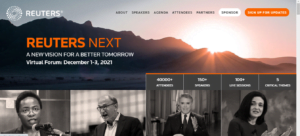
Here are a few other virtual and hybrid event strategies that are paying dividends:
Virtual – Sell premium perks. While registration was mostly free for Reuters Next, they sold “professional passes” costing $699 offering a post-event report and access to a networking program which enabled one-to-one meetings with attendees and speakers. “This is something that both parties would opt into and the system would set up a time for you to connect,” says London. “It’s similar to real world [conferences] but with some advantages; so you are not standing on the outside of a circle waiting for a break in the conversation.”
Hybrid – Do what’s best for each audience. At Meeting Professionals International’s recent World Education Congress (WEC)—600 in person, 1000 virtual—virtual sessions were conducted by many of the in-person presenters but at different times and days, Informa’s Meetings Net reported. “The only in-person sessions that were livestreamed were our general sessions, and we engaged the virtual audience in real time with things like ‘fan cams’ and a European region co-host,” says Melinda Burdette, director of events for MPI. Adds James Frankis, director of product for Convene: “The key is to build in a few ‘peak moments’ that are simultaneous for both, such as keynote presentations and critical breakout sessions—opportunities for the two audiences to come together through real-time surveying that guides the direction of a session.”
Virtual – Be interactive. “Say I’ve got a half-hour experience that I’m creating—the audience is an important part of that experience,” said John Capano, SVP of Impact XM. “So yeah, I’m going to deliver some content, but in between the content, what am I going to do to get that audience engaged? And it’s just being thoughtful about that, based on what is the content? What is the event? What is the audience? And what is their appetite for that?” At Reuters Next, all delegates had access to Q&A and audience polling.
Hybrid – Be confident in your pricing and prepare your staffing. For that WEC event, MPI charged $799 for the in-person experience, which featured four concurrent sessions in each time slot; and $299 for virtual attendees who got three concurrent sessions per time slot. However, they “underestimated the number of staff needed to manage the digital experience,” said Jessie States, director of the MPI Academy. “You need a moderator for each room to monitor the chat, mute participants and generally manage the technology.”
Virtual and Hybrid – Emphasize sustainability. Almost 3/4 (74%) of their audience told Condé Nast that companies behaving more sustainably took on more importance because of coronavirus. Young people especially have indicated in surveys that it affects their decision-making. “Live events take a lot and have a big carbon footprint,” Capano said. “And so doing an event where maybe it’s a smaller live portion, but a much larger online portion, you can get the same benefit and the same engagement for a much smaller carbon footprint. And obviously, that is important and should be important to many of the folks that we work with. So this is really a ton of benefits there.”
Hybrid – Don’t let anyone feel like they’re missing out. States from MPI said that some of their “digital participants expressed interest in a few in-person sessions that were not offered virtually. Our takeaway is that we should capture those in-person sessions for on-demand viewing.” FOMO is real. While virtual cannot replicate the networking and exhibit hall, it should be able deliver on content.


